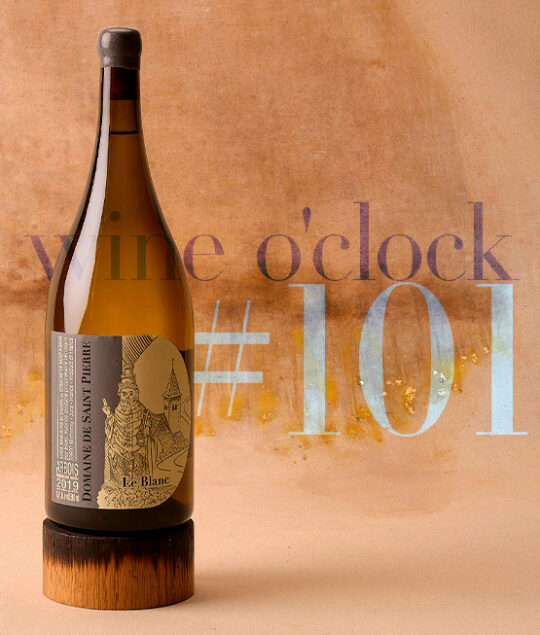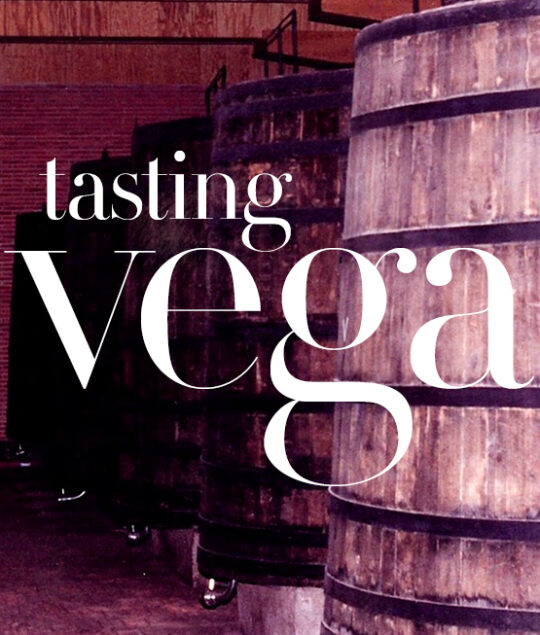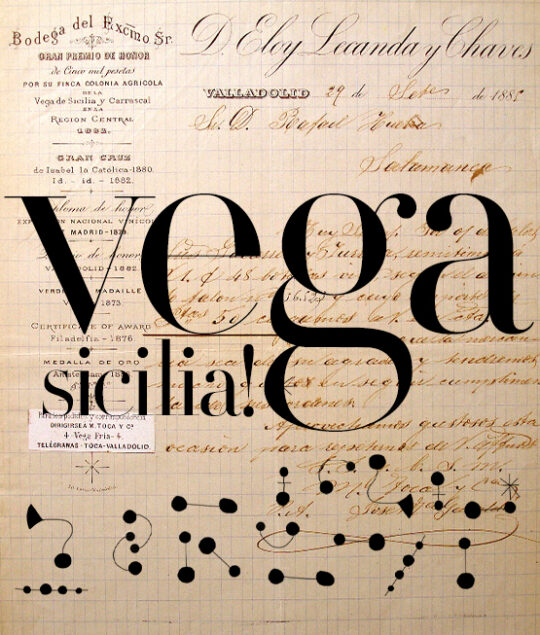“La Romanée Memories” | In the archives with Christophe Bouchard
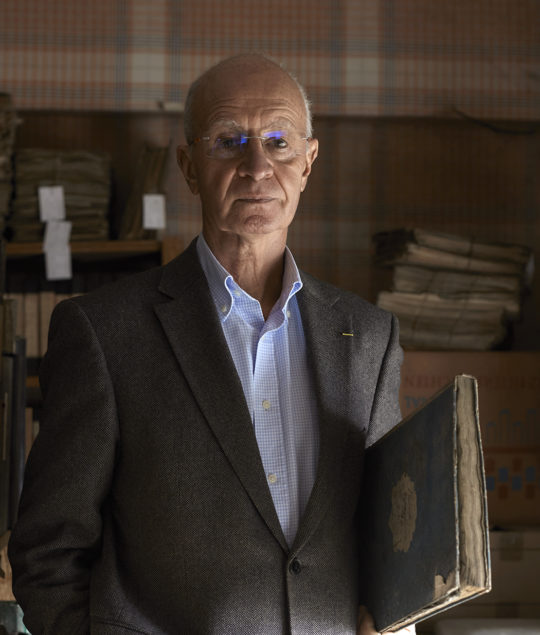

By Julie Carpentier
“ It is a journey through time. One would have to immerse oneself
for days, weeks, whole months to be able to dissect all its substantial marrow.”
—
Baghera / wines : Christophe, you do us the honour of being our guide among the countless archives of Bouchard Père & Fils, collated and preserved by your ancestors here at Rue du Château in Beaune. There are many testimonials of the relationship between the Maison Bouchard and the grand cru, La Romanée.
Christophe Bouchard, Archives Consultant, Bouchard Père & Fils : Among the many testimonials kept here in the company archives, I will first show you a label of this famed bottle of Romanée. Bouchard Père & Fils had an establishment in Bordeaux and that’s why we see the mention “same establishment in Bordeaux” : it was in fact a shipping counter that was used for exports to the United States, England, Norway and Russia. Here are some other labels from La Romanée with the mention “same establishment in Bordeaux”. These labels were in use until about 1910.
I have found circulars that give an overview of the vintages from 1900 to 1932. The 1906 vintage: “average harvest – so when we say average, it is a harvest of average volume – excellent quality – robust and full-bodied wine – very generous – when we say very generous, these are wines that generally have a high alcoholic potential – robust and full-bodied ”. The 1911 vintage “an excessively small quantity – either due to a spring frost or to weather conditions – the quantity was very small but the quality was exceptional”. The 1915 vintage “average harvest – still in terms of volume – very generous, full-bodied wines that will have to be awaited for some time”. This implies that these are wines which were certainly very tannic and which took some time to improve in the bottle.
All these documents that have been collated were written by my ancestors. Each year after the harvest, a letter was sent to customers and suppliers to give them an overview of the harvest. I’ll read this, “Beaune November 1906. In Burgundy, the vine adapts wonderfully to the scorching seasons. The year 1906 from beginning to end was therefore particularly favourable to our vineyard and produced wines with a promising future. Quality: colourful wine, spirited, the wines of the lastest harvest have an absolute clarity of taste and great finesse.
Their firmness also predicts a long life – therefore certainly a little tannin – which guarantees them a bright future. Quantity: on the other hand, the quantity is very small in proportions varying from a quarter to a third of the production of an average year. A small quantity of excellent quality. This is the summary of the situation. Furthermore the estate is not willing to accept the low prices which have too often been the result of disastrous circumstances – implying too large volumes in previous years – for the moment the prices of 1906 are at the price of the beginning of the excellent 1904 and we can deduce with certainty that they will rise in the future”. And as always a little reminder of the previous vintage: “the pleasant but light 1905 wines have found their use in everyday consumption”.
Concerning the 1911 vintage, in the archives there is a document drawn up by the Comité de Viticulture de Côte d’Or, i.e. a certain number of wine merchants and owners who would meet each year on the morning of the exhibition held on the day of the big wine sale: “the jury in charge of tasting the new wines presented at the fiftieth exhibition of the Beaune district agricultural committee and the Côte d’Or viticultural committee met on Sunday 12th November 1911 in the main hall of the Chamber of Commerce. The assembly made the following assessments: This year, thanks to the persistence of good weather and exceptional warmth, the wines of Burgundy are living up to their ancient renown and are worthy of their illustrious origin. A harvest favoured by glorious weather, totally healthy vines and perfectly ripe grapes, have given us in 1911 wines of remarkable quality combining body, colour, bouquet, finesse and a high degree.
Everything contributes to forecasting for the 1911 harvest, a remarkable and assured rank among the great years. The quantity is very small and the vines of great wines have generally produced a yield well below average. This laudable appreciation was in all points confirmed the very same day by the splendid results of the sale of the Hospices’ wines, whose vintages were fiercely contended and sold to the applause of the crowd at fantastic prices. The Beaune Chancellor Nicolas Rolin, king of the sale, obtained the splendid price, unheard of to date, of 3,700 francs each”.
“ This is the poster presenting La Romanée at the New Orleans exhibition in 1884-1885, where La Romanée 1865 won first prize.”
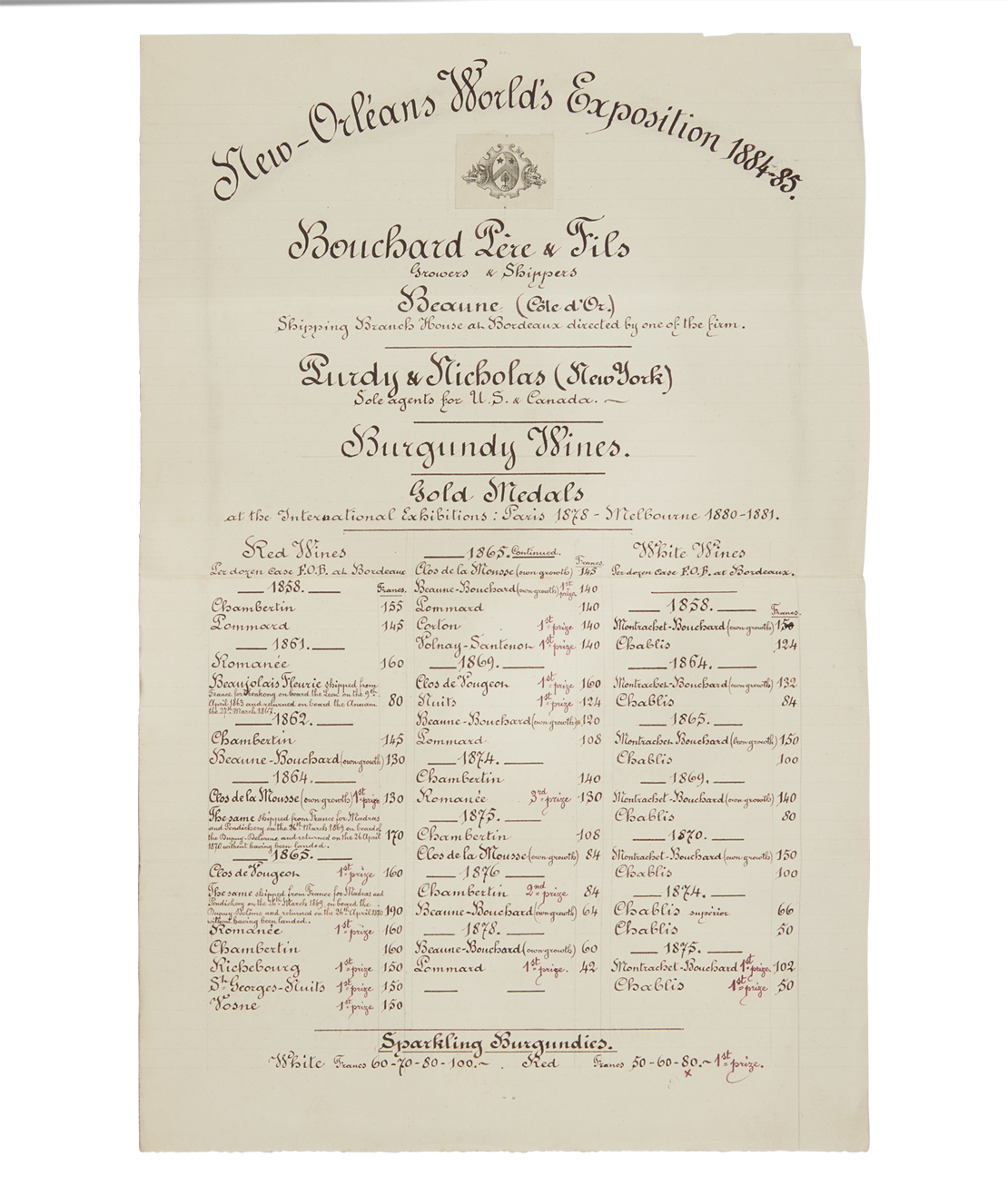
I am now going to show you a poster which shows that Burgundy wines, and La Romanée in particular, were already at the time extremely sough-after. This is the poster presenting La Romanée at the New Orleans exhibition in 1884-1885, where La Romanée 1865 won first prize. We see that the wines presented here were also presented in Paris in 1878 and in Melbourne, Australia in 1880-1881. And here we find La Romanée 1865 having won first prize. All these old vintages were vintages that were marketed by Bouchard Père & Fils, bought in bulk at the time, sometimes just one, sometimes several, sometimes almost the entire harvest depending on the year, and these wines were then distributed to the customers of Bouchard Père & Fils.
I have also found a book of circulars concerning the 1862 vintage, again circulars sent by Bouchard Père & Fils to its customers. “As every year at the same time, we wish to inform you of the situation of our vineyard after a season which, as a result of very opposing atmospheric influences, has brought us from the greatest hopes to the most well-founded fears. We have a harvest whose yield can be estimated at that of an ordinary year. So there is a careful choice to be made among the 1862 wines. The time of the harvest, hastened by some, delayed by others, is one of the main reasons for the variation that can be seen in the success of a single wine.” All this to say that the choice of harvest date is very important in the quality of a vintage.
Going through these archives with you, Christophe, is like travelling back in time. It is a journey through time. One would have to immerse oneself for days, weeks, whole months to be able to dissect all its substantial marrow.
Here, I recently found some documents in a crate left to me by my grandfather. They are in fact winegrowers’ accounts. The estate was actually shared between different winegrowers who were responsible for the exploitation of each of the plots, and these winegrowers were the ones who hired grape-pickers and seasonal staff when they needed them. I found an account from 1865 with the harvest at Clos de la Mousse. For example: on September 14th, 157 baskets, 34 baskets. On September 15th: 10 baskets, 8 baskets in the plot next to it. At Clos Landry: 150 baskets on 13th September 1865. The winegrowers noted the number of baskets collected to keep the accounts and they also noted the number of pickers they had employed in order to pay them.
You see, here I found a vintage notebook from Beaune 1813, with the dates of the harvest hampers. The harvest at Pommard and Volnay was set for October 11th, Beaune for October 12th, Chassagne for October 13th, etc. All the details of the year are recorded as well as the number of pickers. A grape picker in 1813 was paid 18 centimes and basket carriers 22 centimes.
“ Bouchard Père & Fils has always
kept old documents, old notebooks. Everything was recorded in them.”
To what extent do these testimonies on the conditions of old and even very old vintages nourish Bouchard Père & Fils’ thoughts on contemporary vintages ?
These documents are very important. Bouchard Père & Fils has always kept old documents, old notebooks. Everything was recorded in them. Everything has always been recorded, which makes it possible in more recent vintages, when faced with a somewhat exceptional or unusual quality, to find in the past the way in which this quality – if it ever existed – was dealt with.
In these archives, we can find the dates of harvest of all the old vintages. This allows us to follow the evolution of the maturity of the grapes as it occurs today. We can see that in the past the harvest often took place at the end of September/early October, sometimes even mid-October. Nowadays, the harvest takes place around 15th September or even earlier (end of August). This clearly shows an acceleration in ripening and precocity. We can also see that production varies greatly from one year to the next. Indeed, there were very variable climatic conditions from one year to the next with frosts that could be very harsh.
This information is invaluable for the winemakers and vineyard managers of today. History continues, and history was passed on with the arrival of the Henriot family. Nowadays, the notes are no longer taken in small notebooks by hand but are carefully archived in the hearts of computers. These archives are beginning to be exploited and scanned in order to preserve their continuity.
Beaune, December 16, 2020
